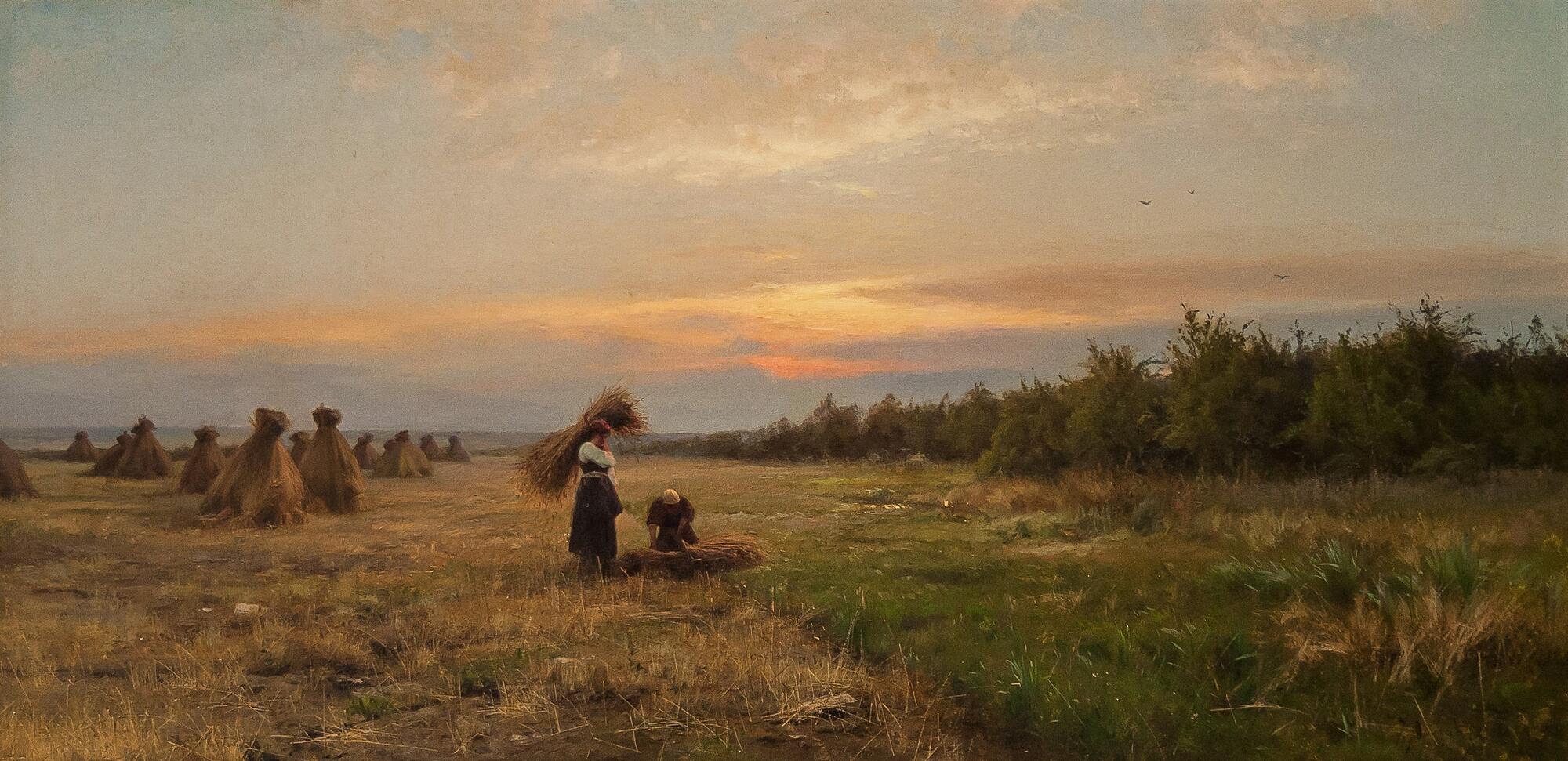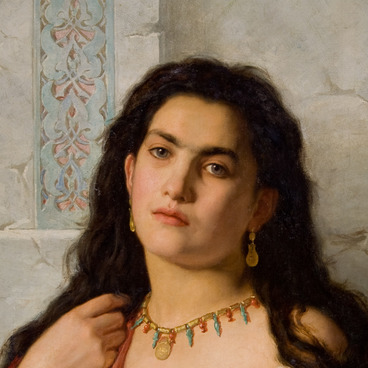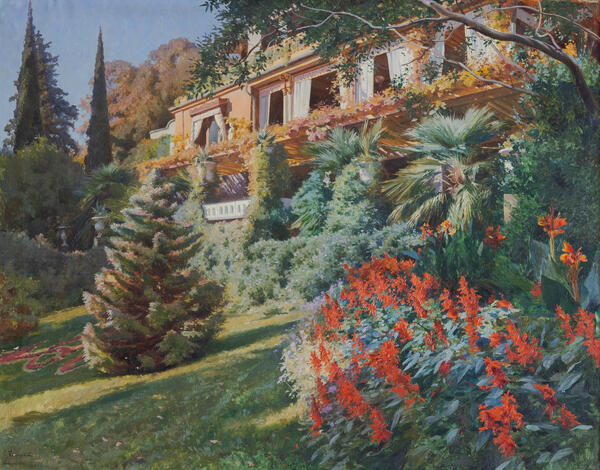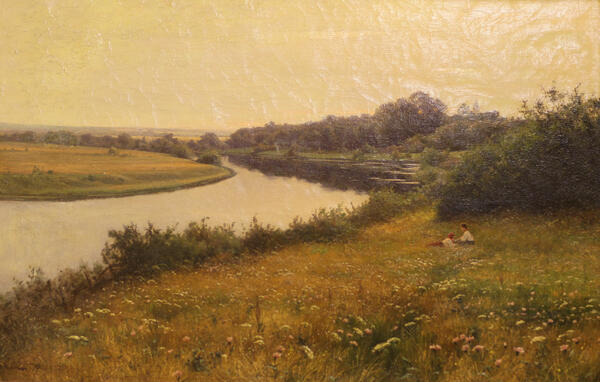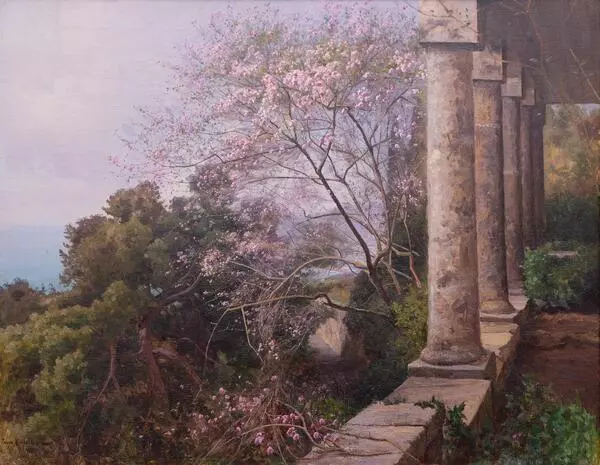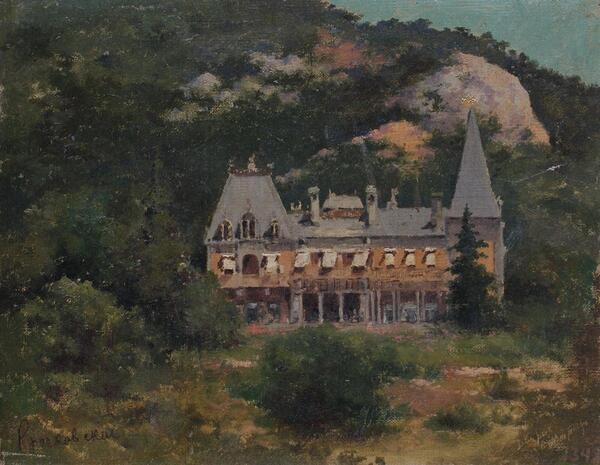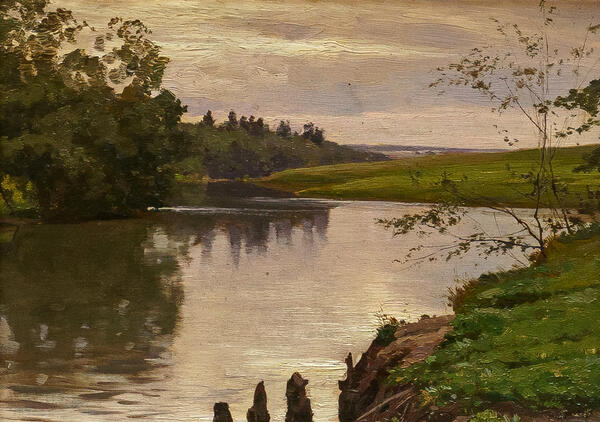Landscape painter Iosif Krachkovsky was born on July 3, 1854, in Warsaw (in some sources—in St. Petersburg) in a middle-class family. After graduating from the St. Petersburg gymnasium, he studied at the Conservatory for several years, and from 1871, he began to attend the St. Petersburg Academy of Arts as a non-matriculated student. His mentor was Mikhail Clodt, a professor of landscape painting.
In 1878, Krachkovsky was awarded a minor gold medal for the painting ‘Morning’, and then a magor gold medal for the painting ‘Evening’. In 1880, he went abroad, visited Berlin, Dusseldorf, Munich, Milan, and Madrid, and lived in Paris. He returned to Russia in 1884 and received the title of academician for the works brought from abroad.
In 1884, Krachkovsky painted the picture ‘Harvest Gathering in the Evening Light’, displayed at the exhibition. It combines the traditions of Russian realists and French artists of the Barbizon school, who created an independent kind of realistic landscape. A characteristic technique of the Barbizon school was the plein air painting, followed by the completion of the work in the studio.
The figures of peasant women in Krachkovsky’s painting are organically integrated into the surrounding landscape. The horizon line is formed by a crimson sunset with a golden hue. It also creates a perspective, highlighting the foreground and plunging the rest of the landscape with trees and the sky into shadow.
The picture was painted in a glazing technique in the spirit of the academicians of the first half of the 19th century. This technique is performed by applying translucent paints over the main tint to create deep iridescent colors. The ability to work with shades, the accurate transmission of the light-air environment, and the fullness of the landscape with air were characteristic of Krachkovsky’s landscapes.
The artist painted ‘alla prima’, that is, painting on the wet layer before the applied paint becomes dry. Krachkovsky believed that a large number of layers harm the brightness of colors.
The artist often participated in academic exhibitions, received positive reviews from critics. In the 1890s, Krachkovsky went to the Crimea, painted in Livadia, Massandra, and Oreanda, fulfilling commissions from the Russian nobility and the imperial family.
In 1902, Krachkovsky’s first personal exhibition was held, which the emperor and his family visited. Nicholas II acquired several works of the master, which later turned out to be in the collection of the Russian Museum of His Imperial Majesty Alexander III. The success of this exhibition made Krachkovsky really famous, he began to receive numerous top orders; Russian and European collectors became interested in his work.
Krachkovsky held the following personal exhibitions in 1908–1909 in Paris and Nice. His works appeared at exhibitions of the Wanderers (Peredvizhniki) and the St. Petersburg Society of Artists. In 1913, he joined the Arkhip Kuindzhi Society.
Krachkovsky died on April 18, 1914, in the town of Cadenabbia in Italy. The artist’s body was brought to St. Petersburg and buried at the Smolensky Orthodox Cemetery. His grave has not been preserved to this day.
In 1878, Krachkovsky was awarded a minor gold medal for the painting ‘Morning’, and then a magor gold medal for the painting ‘Evening’. In 1880, he went abroad, visited Berlin, Dusseldorf, Munich, Milan, and Madrid, and lived in Paris. He returned to Russia in 1884 and received the title of academician for the works brought from abroad.
In 1884, Krachkovsky painted the picture ‘Harvest Gathering in the Evening Light’, displayed at the exhibition. It combines the traditions of Russian realists and French artists of the Barbizon school, who created an independent kind of realistic landscape. A characteristic technique of the Barbizon school was the plein air painting, followed by the completion of the work in the studio.
The figures of peasant women in Krachkovsky’s painting are organically integrated into the surrounding landscape. The horizon line is formed by a crimson sunset with a golden hue. It also creates a perspective, highlighting the foreground and plunging the rest of the landscape with trees and the sky into shadow.
The picture was painted in a glazing technique in the spirit of the academicians of the first half of the 19th century. This technique is performed by applying translucent paints over the main tint to create deep iridescent colors. The ability to work with shades, the accurate transmission of the light-air environment, and the fullness of the landscape with air were characteristic of Krachkovsky’s landscapes.
The artist painted ‘alla prima’, that is, painting on the wet layer before the applied paint becomes dry. Krachkovsky believed that a large number of layers harm the brightness of colors.
The artist often participated in academic exhibitions, received positive reviews from critics. In the 1890s, Krachkovsky went to the Crimea, painted in Livadia, Massandra, and Oreanda, fulfilling commissions from the Russian nobility and the imperial family.
In 1902, Krachkovsky’s first personal exhibition was held, which the emperor and his family visited. Nicholas II acquired several works of the master, which later turned out to be in the collection of the Russian Museum of His Imperial Majesty Alexander III. The success of this exhibition made Krachkovsky really famous, he began to receive numerous top orders; Russian and European collectors became interested in his work.
Krachkovsky held the following personal exhibitions in 1908–1909 in Paris and Nice. His works appeared at exhibitions of the Wanderers (Peredvizhniki) and the St. Petersburg Society of Artists. In 1913, he joined the Arkhip Kuindzhi Society.
Krachkovsky died on April 18, 1914, in the town of Cadenabbia in Italy. The artist’s body was brought to St. Petersburg and buried at the Smolensky Orthodox Cemetery. His grave has not been preserved to this day.
